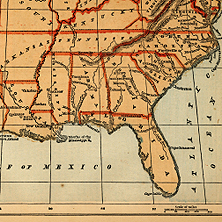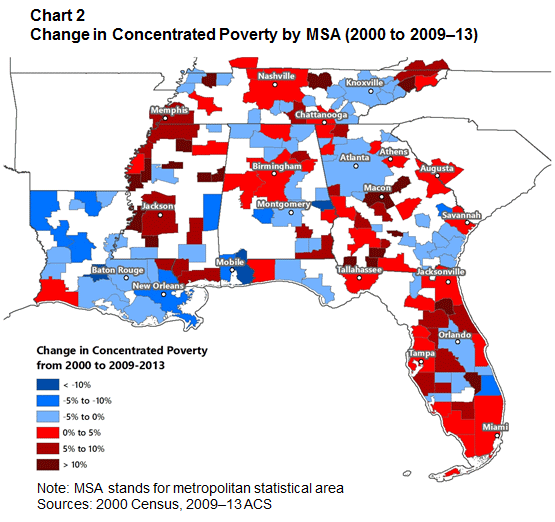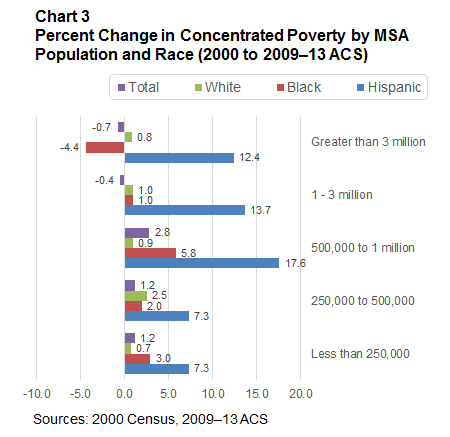
Living in poverty is never easy. But when poverty is concentrated in a specific neighborhood, things can be even worse. High-poverty neighborhoods typically have decreased access to services, struggling schools, and limited job opportunities. Research has shown that life outcomes for poor children who grow up in high-poverty neighborhoods are much worse than similar children who move to low-poverty neighborhoods.1 If the concentration of poverty—the proportion of the poor who live in high-poverty neighborhoods—increases, it could mean more persistent levels of poverty. This begs the question: how have patterns of concentrated poverty changed in the Southeast since the Great Recession?
According to "Exploring Concentrated Poverty in the Southeast," a new student paper by Abram Lueders, the answer is complicated. The paper found that some southeastern cities have experienced a reduction in concentrated poverty since the recession, while others have seen concentrated poverty soar to new levels. The paper also compares concentrated poverty in the Southeast with national statistics from a study by Paul Jargowsky of the Century Foundation. As shown in chart 1, the comparison reveals that the overall level of concentrated poverty in the Southeast has increased in recent years, but at a lower rate than in the nation as a whole.

In both studies, census tracts were used as a proxy for neighborhoods, and tracts with a poverty rate above 40 percent were considered "high-poverty." The national numbers from Jargowsky's study show that after a sharp decline in concentrated poverty during the 1990s, the rate of concentrated poverty, or the percentage of the poor living in high-poverty neighborhoods, has steadily increased. But in the Southeast, concentrated poverty continued to decline in the years leading up to the recession before experiencing an uptick during the recovery period. On the surface, this seems to suggest that changes in southeastern concentrated poverty are largely tied to broader economic cycles, rather than being a sign of deeper structural problems.
While this may sound positive, the geographic differences in chart 2 illustrate that there's no single story in the Southeast with respect to changes in concentrated poverty.

Some southeastern metros—including Jackson, Memphis, and Macon—have experienced significant increases in concentrated poverty since 2000. Others, like Atlanta and New Orleans, have actually experienced a decline in concentrated poverty. Changes in concentrated poverty varied between racial and ethnic groups, and between metros of different size classes, as shown in chart 3.

Metros in the two largest size categories saw modest declines in concentrated poverty. Meanwhile, the largest increase in concentrated poverty occurred in midsized metros with a population between 500,000 and 1 million. Among racial and ethnic groups, Hispanics experienced the largest increase in concentrated poverty in metros of every size class. This could be due to the fact that a large proportion of Hispanic residents are first-generation immigrants, a population group that often clusters in lower-income neighborhoods.2
In Jargowsky's original paper, he argues that increases in concentrated poverty are the result of deliberate policy choices that have negatively affected inner-city neighborhoods and aging suburbs. According to Jargowsky, these policies include exclusionary zoning in wealthy suburbs, the concentration of publicly assisted housing in the urban core, and massive public investments in continued suburban expansion. In the Southeast, it's certainly true that most high-poverty neighborhoods are still located in the central cities of metropolitan areas. But when you examine the location of high-poverty neighborhoods on a fine-grained scale, some noticeable changes have occurred between 2000 and the 2009–13 ACS. Some inner-city neighborhoods that were high-poverty in 2000 have rapidly become low-poverty, while previously well-off areas nearby have become high-poverty. A good example of this phenomenon can be seen in Macon, Georgia (see chart 4).

Although Macon has experienced a 14 percent increase in concentrated poverty since 2000—the highest in the region—poverty in Macon's downtown and downtown-adjacent areas has dramatically decreased during this period. This illustrates the fact that broad increases in urban poverty can mask trend-bucking changes on the neighborhood scale.
What lessons can we learn from this data? On the one hand, the Southeast seems to be relatively better off than the rest of the country when it comes to concentrated poverty. Concentrated poverty in the Southeast gradually declined between 2000 and the start of the Great Recession, and the increase in concentrated poverty in the wake of the recession has been relatively mild. But these regional numbers mask variation between southeastern metros. While large metros with strong markets haven't suffered severe increases in concentrated poverty, midsized metros like Jackson and Macon have.
The tract-level data further shows that high-poverty neighborhoods are not fixed entities: high-poverty neighborhoods can improve, and low-poverty neighborhoods can decline. The fact that some high-poverty neighborhoods have transitioned to lower poverty levels is heartening. In the case of cities like Macon, it's quite likely that reductions in downtown poverty levels have been the result of deliberate planning and policy. However, the fact that poverty has continued to grow elsewhere is troubling. Concentrated poverty operates at the scale of the neighborhood, the city, and the metropolitan area. If concentrated poverty decreases at one scale but increases at another, no real victory has been achieved.
_______________________________________
1 Chetty, Raj, Nathaniel Hendren, and Lawrence F. Katz. 2015. "The Effects of Exposure to Better Neighborhoods on Children: New Evidence from the Moving to Opportunity Experiment." Harvard University and NBER. http://www.equality-of-opportunity.org/images/mto_paper.pdf.
2 Jargowsky, Paul. 2006. "Immigrants and Neighborhoods of Concentrated Poverty: Assimilation or Stagnation?" National Poverty Center. http://www.npc.umich.edu/publications/u/working_paper06-44.pdf.


